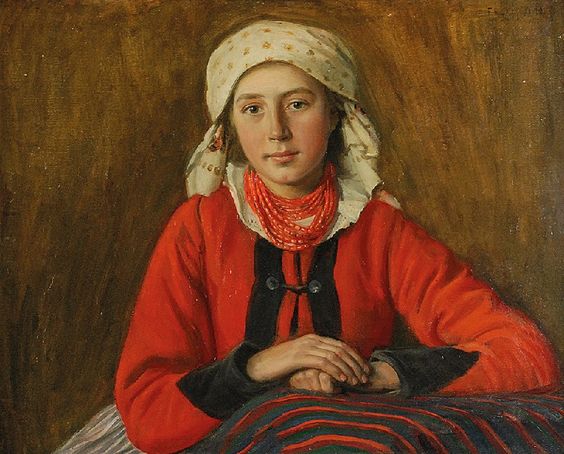Korale – the red beads
Korale beads (korale is the plural form of Polish koral, meaning coral) were introduced to Poland in the 19th to beginning of the 20th century. The most valuable pieces were made of coral, but there were also cheaper alternatives made of glass, porcelain, and rubber, and also a mixture of rubber and plaster. They were imported from Venice and Naples, Italy, and Marseille, France.
They were most popular in southern Poland – most probably due to the fact that Kraków and other cities in the southern regions of Poland had established trade routes with Italy. Rich ladies used to buy red beads in Sukiennice (Cloth Hall) in Kraków from Italian and French merchants. In the northern parts of the country, jewelry made of amber was much more popular (and still is).
The most expensive were natural coral beads with a spherical shape. Oval beads were less expensive. Women wore three to six cords, usually an odd number, with the shortest strand at the neck and the longest being the lowest. The largest beads were placed in the middle of the strands. From that point, the remaining beads were placed on the strands in descending order by size.
It was not uncommon to tie a small holy medal or a cross to a string of beads. Korale were worn with a festive outfit, except for Advent and periods of fasting or mourning, during which time women wore beads made of jet, black glass, or dark carbuncles). They also were an important element of wedding attire with real coral beads, due to their rarity and value, being part of the dowry.
It was by the number, size, and grade of material being worn that Korale testified to the wealth and social position of the woman they decorated. At the time, a triple strand of real coral beads was worth four or five cows, or one morga/mórg, an old land measure equal to about 1.4 acres. Thus, real coral strands were treated as a capital investment that also had the advantages of portability and easy divisibility to smaller units. They were a store of wealth to be passed from mother to daughter. Furthermore, these advantages and their value made Korale of real coral acceptable as a pledge for money loans.
Less wealthy young women, in order to collect money for even a modest string of beads, earned money toward their acquisition by working in service on an estate, undertaking various odd jobs, or engaging in seasonal work. Poorer girls who had no hope of acquiring even a couple of real beads wore artificially colored beads made of common material such as wood or, in some circumstances, bread that was dyed red.

In addition to wealth and status, korale held folkloric attributes. It was believed that real coral possessed magical power including protection against charms, diseases, and various ailments such as epilepsy and severe headaches. Some believed the fading of korale – which takes place naturally over time in real coral – was the first sign of a serious disease to its owner.
Red korale are still an important part of many Polish folk costumes – mostly made of wood or plastic nowadays, but they never went out of fashion and are a must-have attribute of the folk and country look.
This article was published in Spring 2021 issue of PGSA magazine “Rodziny”.


Leave a Reply